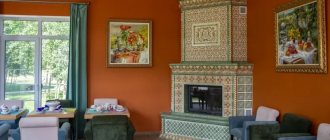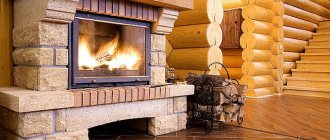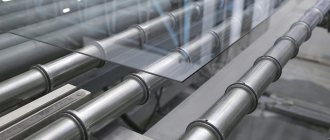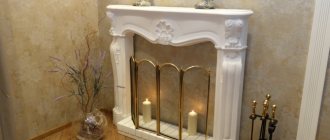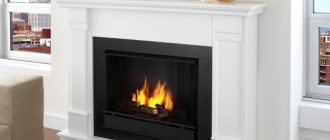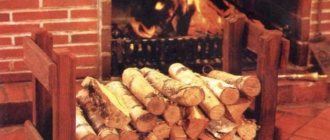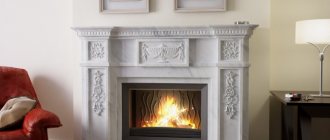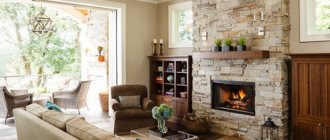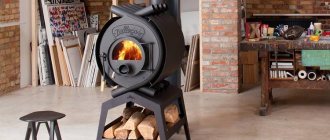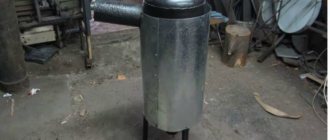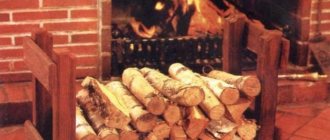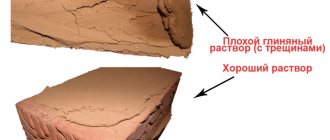If you want to radically change your interior and make it memorable, install a fireplace. Unfortunately, urban high-rise buildings are not designed to accommodate a real fireplace, with tongues of flame and the soft crackling of logs. However, there is a way out - you can build a false fireplace, decorating it with stucco molding purchased or made yourself.
Making a fireplace from stucco with your own hands is not an easy, but completely doable task.
We will look at several ways to make such fireplaces, with step-by-step instructions and a list of necessary materials and tools.
Stucco molding and what it is
The concept of “stucco molding” includes parts or figures made with relief patterns. Such fragments can be produced in several ways, one of which involves pressing, and the second method involves casting. In one case or another, the resulting decorative details can be used both for external facades and for interior spaces.
It is produced both on an industrial scale and at home. The second option is more expensive, since you will have to additionally pay for the development of the sketch and production of the mold. On a production scale, standard parts are produced, so the price is quite affordable.
False fireplace as an interior tool
An imitation fireplace is a composition made from a frame, inside of which there is no fire, but you can place decorative candles, figurines or frames. The decor of a false fireplace allows you to create an aura of serenity even in a small city apartment. The back wall of the fireplace can be made mirrored or lined with decorative tiles.
An imitation fireplace is used for photo sessions, for example, in thematic areas of photo studios. Parents often create false fireplaces with their own hands to equip a group in kindergarten: children also love to take pictures in front of such a cozy “stove.”
Choice of stucco
Element of stucco decoration made of polystyrene foam
The choice of decorative stucco molding for a fireplace is made based on the type of fuel that is used for it. Regarding this, there are two types of hearth design:
- Natural fireplace.
- Electric fireplace.
If the finishing material option is incorrectly determined, soot, carbon deposits or other traces of equipment use will appear on the finish. The main task when using decorative fragments is to harmoniously complement the main structure with the interior where it is located.
Based on the production technologies of gypsum portals, there are three main types:
- Profile. When the portal is decorated with various details of finishing material: pilasters, friezes, moldings.
- Sculptural. When the main role is played by the central part of the portal, decorated with various figures, atlases, frescoes, bas-reliefs or caryatids.
The fireplace area – merging with the interior
Space for creativity is provided not only by the fireplace itself, but also by the area near it. The transition of the wall from the hearth to the main walls can be implemented in a single style. For example, decorating the walls in the form of shelves for logs. For an aesthetic appearance, carefully processed logs of the same size are laid.
Mirror surfaces or areas with fascia are successfully combined with a fireplace. Mirrors frame and decorate this visual center of the room. Electric models are equipped with side vertical shelves on which figurines or framed photographs look beautiful.
Kinds
Options for decorative elements made of stucco Stucco can be made from various materials, natural or synthetic.
In addition, if desired, you can make parts in a shape reminiscent of natural stone. To better match the interior, the manufactured fragments can be painted in a suitable color. The main materials for the manufacture of decorative elements are:
- Gypsum,
- Fiber concrete,
- Polyurethane.
Each type has advantages and disadvantages, so when choosing parts, you need to study all its properties.
[ads-mob-1][ads-pc-1]
“Stucco molding” in the apartment – “Independent work”
Gypsum
Gypsum has the following advantages:
- No shrinkage.
- Fireproof properties.
- The structure is quite flexible for pouring into any shape.
- When making decorative details with your own hands, the blanks used are very pliable, do not crumble or chip.
- Long service life.
- Moisture absorption.
Directions for using gypsum binders
Among the disadvantages are:
- The gypsum structure is heavy.
- The finished product is quite fragile.
- In the absence of a polymer coating, gypsum parts can only be cleaned dry.
- Quite a high price.
- Making a portal from plaster yourself is almost impossible.
Fiber concrete
Fiber-reinforced concrete is a type of concrete based on reinforcement.
Among the advantages of the material are:
- Manufacturing of any parts.
- It has excellent contact with colors, resulting in elements similar to natural stone.
- Durability of the finished product.
- Durability.
- Not exposed to moisture.
Polyurethane
Types of thermoplastic polyurethane
Polyurethane is a material of synthetic origin. Despite the fact that manufacturers claim that it is harmless to humans, many prefer to avoid it.
Advantages of the material:
- Light weight structure.
- Easy to care for.
- Resistance to mechanical stress.
- The properties of the material allow us to produce any elements.
- The surface is perfectly painted.
- It has a smooth surface without pores, which prevents contamination.
- Resistant to moisture.
- Strength.
- Durability.
- Safety for humans.
Advantages of the material
Gypsum is a type of inexpensive and accessible material used in home crafts for decorating various surfaces, including fireplace portals.
Comparative characteristics of technical parameters of gypsum
It demonstrates a number of advantages that attract craftsmen:
- environmental Safety;
- the ability to absorb excess moisture from the surrounding atmosphere and release it if the air becomes excessively dry;
- fire resistance, which allows the use of gypsum in the design of the facades of fireplaces that operate by burning different types of fuel;
- durability without loss of decorative qualities;
- no shrinkage causing deformation.
Artificial stone made of gypsum
Attracts the possibility of using a variety of techniques for decorating gypsum elements: tinting with acrylic or water-based paint, imitating the natural textures of stone, brick or wood, gilding, painting.
Before painting, two coats of primer must be applied. Since gypsum is not a conductor of electric current, it is an ideal finishing for portals for electric fireplaces.
Recommendations for installing stucco elements
Decorating a fireplace with stucco
Using these tips, you can diversify and harmoniously fit certain figures into the main structure, as well as complement and transform the style of the room.
- If the style of the room is made in a medieval direction, then the fireplace portal must be decorated with “stone stucco”. This will give massiveness and fundamentality to the main product.
- For an antique style interior, material in a classic style is suitable. It can also be used for a medieval style; the interior will only benefit in this case.
- To create home comfort, you can use a version of the material with elements of aging.
- And to give the fireplace a touch of individuality or exclusivity, you can use a combined design method, using elements from various materials.
[ads-pc-2][ads-mob-2]
Decoration ideas for holidays and other events
Even the simplest fireplace can be easily decorated with available materials; this usually does not require any special knowledge or skills. For each holiday, its own type of decor is selected, which changes when the event has already ended or the time for another one approaches. For example, on Valentine's Day the design is decorated with a bunch of hearts, panels with declarations of love, on Halloween - a pumpkin with slits in the shape of a face, with a lit candle inside. By March 8th or February 23rd, the corresponding numbers are made from scrap materials, decoration is carried out in red-pink or blue-blue tones. Graduation from a university or other educational institution, retirement, housewarming, or the birth of a baby are decorated depending on the tastes of the hero of the occasion or his relatives.
For the wedding
White candles in candelabra, porcelain doves, paper hearts and flowers will make the holiday luxurious. The fireplace itself symbolizes the hearth; a good idea would be to make it the center of the wedding interior. Often used are bouquets of white roses, crafts made of foam plastic, light garlands made of paper, photos of the newlyweds, panels with their names, ribbons of pastel colors with wishes of happiness written on them.
For your birthday
A photo or a whole series of photos of the birthday boy will be located on the mantelpiece, next to his favorite drinks. A garland of colored paper flags, aluminum foil, lots of balloons, and words of congratulations above the fireplace will immediately create a feeling of celebration. Decorative candles, flowers, soft toys, items related to the activities of the person being congratulated will be an original addition. Colorful postcards will also decorate the interior.
To spring
Spring fills the house with freshness, so the spring-summer hearth is decorated with primroses in vases, tulips or daffodils, grown independently in pots, fluffy willow branches, artificial plants, and herbal wreaths. A birdhouse, figurines of birds, photographs of awakening nature are placed on the mantelpiece, and beautiful gardening tools are placed next to it. Decorating the fireplace with small panels made from slices of wood, with images of cherry blossoms and willow branches, will create an organic interior. For summer design, a marine theme with shells, models of sailboats, and photographs of sunsets over the water is suitable.
For Christmas and New Year
Decorations made from spruce and pine branches will come in very handy for the New Year holiday. They are decorated with Christmas tree decorations, painted pine cones, foam snow, and gold spray paint. LED garlands and tinsel are placed around the perimeter, baskets are placed on the shelves, tangerines and sweets are placed there, decorative socks are hung above the hearth itself, in which Santa Claus should put gifts. Bright cardboard boxes are placed on a shelf or nearby, paper stars, snowflakes, Christmas angels complete the picture.
For Easter
An indispensable attribute of this celebration is an egg. Painted chicken or homemade foam eggs in baskets woven from wicker or newspapers are placed on the mantelpiece, Easter cakes, Easter bunnies, porcelain angels, and spring greens in vases are also placed there. Paper and fabric garlands with images of eggs, colored cardboard decorations, textile balls, and embroidered elements complete the interior.
Types of portals
Portals may differ in style and materials of manufacture
. Fireplaces are complex devices; the choice of option for purchase or self-production is approached responsibly.
At the design stage the following is determined:
- purpose - heating, decorative function, combined option;
- type of energy carrier - firewood, biofuel (ethanol), electricity, natural gas;
- type of allocation;
- portal style;
- type of building material for production.
Functions and fuel
Devices that are designed for heating can burn wood, coal or gas.
In urban apartments, installation of products of this kind is impossible. To remove deadly combustion products and caustic smoke, you need a chimney with high capacity. Sanitary standards prohibit connecting the pipe to a public access hood. In addition, there will definitely be complaints from neighbors whose smoke will enter their home.
Electric fireplaces are equipped with 1.5–2.5 kW heaters, capable of maintaining the temperature in a room of 10–18 m2. Considering the cost of electricity, this heating method is extremely expensive. The devices are turned on for a short time. Electric fireplaces combine the functions of a decorative element and heating.
To create the illusion of flame, electric fireplaces are equipped with special light bulbs.
Biofuel is obtained from the remains of rapeseed, coconut, and soybeans. Ethanol on sale is expensive and it is unprofitable to heat a room with it. Fireplaces serve as a decorative element.
Installation options
For built-in fireplaces, the portal practically does not protrude beyond the wall line
The choice of model depends on the tasks, the size of the room, and the desired style.
There are fireplaces:
- built-in - placed in specially designed niches and recesses, the portal facade does not protrude beyond the wall line;
- semi-open - part of the structure is in a niche, and the front part protrudes into the room;
- corner models are suitable for small rooms, when it is necessary to be economical with usable space;
- wall-mounted options do not have contact with the floor, the size and weight of such products are small;
- open fireplaces are usually located in the center of the room; they serve as a place around which a large group can gather.
For each option, a portal corresponding to the design is selected.
Useful tips from professionals
Construction of a box for a decorative portal requires patience and some skills; at the first stage, advice from professionals will be useful. The most interesting and artistic part of the work is the finishing of the front part.
The traditional way of decoration is wallpapering. Wallpaper hides surface unevenness well, and one layer of putty is enough. The wallpaper is selected to match the tone of the walls from one collection, using a border with an ornament to decorate the facade. The option of covering the box and walls with the same trellises looks good only in fashionable, stylish interiors - Scandinavian, minimalism, hi-tech. In this case, it is better to prefer monochromatic colors. A fireplace covered with floral wallpaper or with monograms looks out of place.
Installation features
In order to assemble fireplaces with your own hands from plaster, you need to familiarize yourself with this step-by-step guide and the useful tips and recommendations presented in it:
- In order to simplify the construction and installation process as much as possible, you can buy ready-made blanks in a specialized store. Such elements require simple fastening to the surface of the frame and subsequent additional coating and surface treatment;
- To make blanks, both polyurethane and gypsum can be used, based on your wishes and preferences;
- Due to its rather large mass, the gypsum portal must be securely fastened. For this, special double-sided fasteners are used. Based on its location, the frame can be attached simultaneously to the wall and floor (corner and wall arrangement), or simply to the floor (island arrangement);
- When making a fireplace with your own hands, you need to assemble a frame from metal profiles, cover it with any heat-resistant material and secure it;
- Gypsum stucco molding must first be formed into certain elements. To do this, you can use special purchased forms. Pour the prepared solution into them and wait for it to dry completely, take out the resulting element, which is completely ready to be fixed on the prepared base.
A simple classic frame that requires additional surface treatment or painting to avoid the characteristic yellowness
Complete fireplace portal made of plaster with a recess for the hearth
Joining elements and hiding gaps with construction sealant
Step-by-step production of various large and voluminous parts
An example of a simple plaster fireplace surround
The video in this article will help you become more familiar with the basic rules and subtleties of assembling a plaster frame.
